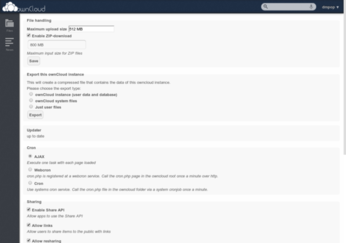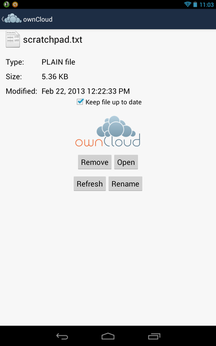Migrating to ownCloud

Productivity Sauce
I've been meaning to move from Wuala to ownCloud for some time, but there were always more important things on my to-do list. Recently, though, Wuala started to act up, so it was time to take the plunge. What can I say? I wish I moved to ownCloud earlier. Deploying the application on my virtual private server took about 15 minutes. I chose the manual installation procedure, but there is also a web-based installer which does the donkey job of installing ownCloud for you.
ownCloud requires practically no configuration. I disabled a few default apps I wasn't planning on using, and that was it. To enable the file synchronization functionality, I installed the ownCloud desktop client on my machines. The ownCloud project offers binary packages for all popular Linux distributions, including all Ubuntu flavors, so installing the client was a matter of adding a repository to the sources.list file and running the apt-get update && apt-get install owncloud-client command. Configuring the client wasn't particularly difficult either. I provided connection info, specified the directories I wanted to keep in sync, and the client took it from there. So far, it works like a charm. Since ownCloud features a built-in text editor, I can access synced files and edit them in a browser.
The ownCloud project also offers an Android app which can be used to access files and documents from an Android device. The clever part is that you can grab a file and keep it in sync by enabling the Keep file up to date option. The app also includes the instant upload functionality, which automatically uploads photos taken with the Android device to ownCloud.
comments powered by DisqusSubscribe to our Linux Newsletters
Find Linux and Open Source Jobs
Subscribe to our ADMIN Newsletters
Support Our Work
Linux Magazine content is made possible with support from readers like you. Please consider contributing when you’ve found an article to be beneficial.

News
-
Zorin OS 18 Hits over a Million Downloads
If you doubt Linux isn't gaining popularity, you only have to look at Zorin OS's download numbers.
-
TUXEDO Computers Scraps Snapdragon X1E-Based Laptop
Due to issues with a Snapdragon CPU, TUXEDO Computers has cancelled its plans to release a laptop based on this elite hardware.
-
Debian Unleashes Debian Libre Live
Debian Libre Live keeps your machine free of proprietary software.
-
Valve Announces Pending Release of Steam Machine
Shout it to the heavens: Steam Machine, powered by Linux, is set to arrive in 2026.
-
Happy Birthday, ADMIN Magazine!
ADMIN is celebrating its 15th anniversary with issue #90.
-
Another Linux Malware Discovered
Russian hackers use Hyper-V to hide malware within Linux virtual machines.
-
TUXEDO Computers Announces a New InfinityBook
TUXEDO Computers is at it again with a new InfinityBook that will meet your professional and gaming needs.
-
SUSE Dives into the Agentic AI Pool
SUSE becomes the first open source company to adopt agentic AI with SUSE Enterprise Linux 16.
-
Linux Now Runs Most Windows Games
The latest data shows that nearly 90 percent of Windows games can be played on Linux.
-
Fedora 43 Has Finally Landed
The Fedora Linux developers have announced their latest release, Fedora 43.


